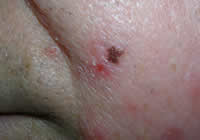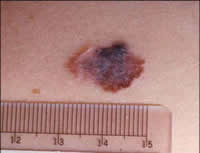Of the three main types of skin cancer, melanoma is the least common. About 4% of skin cancers are melanoma. While melanoma is less common, it is more dangerous.
Melanoma arises from melanocytes, the cells in the skin that make pigment (coloring) and are responsible for tanning. Because melanoma cells still produce pigment, these tumors often appear brown or black.
Melanoma can appear anywhere, but is most common on the back, chest, and legs. Sometimes it arises in an existing mole which begins to change in shape and color. Other times it begins on normal skin and looks like a new mole at first, but continues to grow and change.

Melanoma can strike the young as well as the elderly. In fact, melanoma is the most common cancer in women ages 25-29.
If melanoma is detected in its earliest stages, before it has spread, the cure rate is very high. However, melanoma is much more likely than the other forms of skin cancer to metastasize or spread to other parts of the body. And melanoma can be very dangerous once it has spread. Most cases of melanoma that have metastasized can not be cured. That is why melanoma accounts for only 4% of skin cancers, but 77% of skin cancer deaths.
Four clues to detecting melanoma are known as the ABCD’s of melanoma:
- Asymmetry
- Borders are irregular
- Colors are varied
- Diameter is large ( > 6 mm)

A skin biopsy is necessary to confirm the diagnosis of melanoma. Once confirmed, the tumor must be surgically removed. When a melanoma is surgically removed, a margin of normal skin surrounding the tumor is also removed. After removal, the depth of tumor invasion will be measured by a pathologist using a microscope. That depth, known as the Breslow depth, is the most important factor in determining prognosis.
Because melanoma is so dangerous, it is important to watch the skin for any changing moles. Those who are at greatest risk include people with fair skin, people with lots of moles, and those with a family member who has had melanoma. Any mole that appears to be changing is considered highly suspicious and should be examined and probably biopsied.
Learn more about melanoma from:

